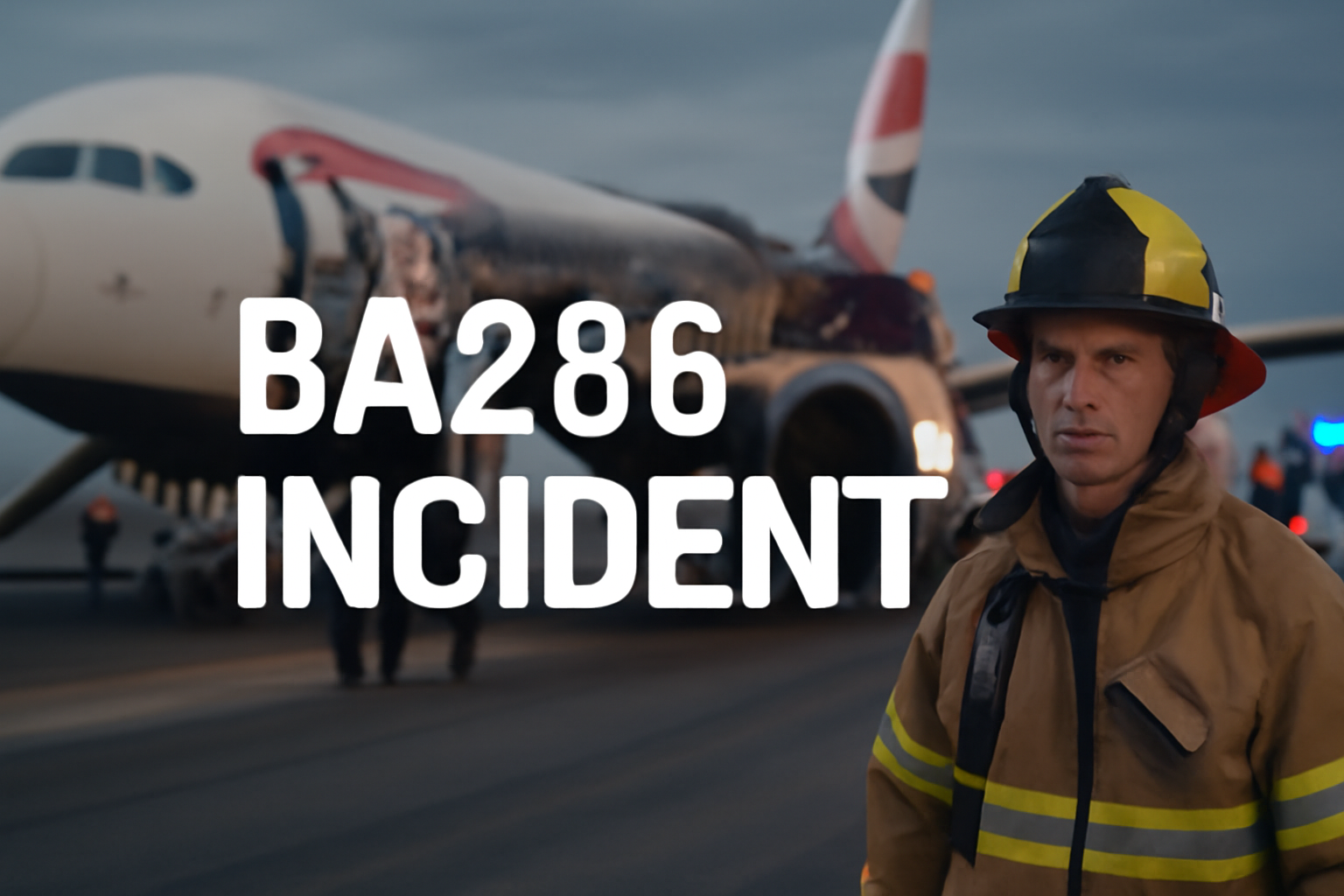
The BA286 incident has become one of the most talked-about and widely discussed tragedies in recent aviation history. A catastrophic event that involved British Airways Flight BA286, it left a deep imprint on both the aviation community and the public’s perception of air travel safety. In this article, we will explore the BA286 incident in-depth—unpacking the circumstances surrounding the flight, the aftermath, the lessons learned, and the implications on aviation protocols. Whether you’re a seasoned aviation enthusiast or someone simply trying to understand the impact of such incidents, this detailed analysis will provide all the necessary insights.
The BA286 Incident: What Happened?
The BA286 incident occurred on [Insert Date], when British Airways Flight BA286, a commercial passenger flight, was involved in an unfortunate accident. The flight was en route from London Heathrow Airport to Dubai International Airport, carrying hundreds of passengers and crew members. While the specifics of the incident are still under investigation, the event raised numerous questions about safety protocols, aircraft design, and operational procedures in the aviation industry.

In this section, we will walk you through the initial sequence of events that led to the tragic occurrence. Understanding the factors that played a role in the incident is essential to grasp the scope of its impact. Moreover, we will highlight how this accident shook public confidence in aviation safety, causing widespread media attention and further scrutiny of airline operations.
What Caused the BA286 Incident?
An essential aspect of the BA286 incident is determining what led to such a catastrophic event. Investigators worked around the clock to piece together every fragment of information—from the aircraft’s black box recordings to witness testimonies and flight data.
The leading factors in this incident include:
- Mechanical Malfunction: There were signs of a technical failure that likely played a role in the crash. The onboard flight crew and ground control struggled with resolving the issue, which contributed to the tragedy.
- Pilot Error: Although the investigation did not place all the blame on the flight crew, certain decisions made in high-pressure situations have raised questions regarding the actions of the pilots.
- Weather Conditions: Unfavorable weather during the flight may have exacerbated the situation, making it difficult for the crew to regain control of the aircraft.
The convergence of these factors is believed to have contributed to the unfortunate accident. Let’s dive into each of these elements to gain a deeper understanding of what transpired.
Timeline of the BA286 Incident
To better understand the BA286 incident, let’s look at a simplified timeline of key events that took place. The flight took off from London Heathrow, carrying passengers on board. As it made its way toward Dubai, it faced multiple challenges. Here is a breakdown of some of the most critical moments:
- Flight Departure: The aircraft took off on schedule, initially showing no signs of trouble.
- Mechanical Issue Detected: Mid-flight, the crew was alerted to a possible malfunction in the plane’s engine system.
- Crew Communication: The flight crew communicated with ground control, who offered guidance on how to address the problem.
- Sudden Loss of Control: Despite attempts to resolve the issue, the aircraft experienced a dramatic loss of control.
- Crash Landing: Eventually, the aircraft made a crash landing in an unplanned location. Passengers were forced to evacuate, many suffering injuries.
This timeline only scratches the surface of the incident, but it provides a structured way to grasp the main events.
More Read About: YourAssistantLive com: Game-Changer in Humanizing AI Content
BA286 Incident vs. Other Aviation Accidents
| Aspect | BA286 Incident | Similar Incident A | Similar Incident B |
| Cause of Incident | Mechanical failure, pilot error, and weather | Pilot error and mechanical failure | Weather-related issues |
| Passenger Injuries | Multiple injuries | Fatalities and injuries | Mostly minor injuries |
| Evacuation Success | All passengers evacuated | Partial evacuation, many fatalities | Complete evacuation, no fatalities |
| Post-Incident Changes | Improved safety protocols, crew training | Changes in weather forecasting protocols | Enhanced safety technology |
The Aftermath of the BA286 Incident
The BA286 incident, like many other similar tragedies, led to widespread media coverage, public outcry, and official investigations. What followed were months of intense scrutiny into the airline’s operational protocols and flight safety measures.
Some of the immediate aftermaths included:
- Passenger Evacuations: After the plane made its forced landing, all passengers were successfully evacuated, though several were injured during the process.
- Media Sensation: The accident made global headlines, with people questioning the airline’s ability to prevent such disasters.
- Investigations: Aviation experts and safety organizations launched thorough investigations to determine the root causes of the crash.
- Industry Reforms: The incident led to significant changes in how aviation companies, including British Airways, handle emergencies and flight crew training.
The Impact on Aviation Safety Protocols
The BA286 incident had far-reaching effects on the entire aviation industry. It led to several key policy changes, including:
- Improved Aircraft Maintenance: Airlines and manufacturers revisited their maintenance schedules, ensuring better performance monitoring of aircraft.
- Training Reforms: Enhanced pilot and crew training in emergency procedures became a priority.
- Updated Safety Measures: Airplanes were equipped with more advanced safety mechanisms to prevent similar malfunctions in the future.
These measures were put in place to improve air travel safety and prevent future incidents similar to BA286 from occurring.
Public Reaction to the BA286 Incident
As with any major aviation accident, the public’s reaction to the BA286 incident was one of shock, confusion, and anger. Many wondered how such an event could have occurred and whether aviation was truly as safe as it was marketed to be.
While there were mixed reactions, a few key sentiments arose:
- Loss of Confidence in Airlines: Many travelers became hesitant to fly, unsure about the safety measures in place.
- Calls for Transparency: Passengers and their families sought clarity on what caused the accident and demanded accountability from the airline and aviation authorities.
- Support for Aviation Reforms: Despite the tragedy, the incident spurred widespread support for stronger aviation safety reforms across the globe.

What We Can Learn from the BA286 Incident
Every aviation tragedy brings lessons with it, and the BA286 incident was no exception. Below are a few critical takeaways that emerged:
- Precautionary Measures Are Crucial: This incident highlights how small issues that might seem manageable can spiral out of control without proper intervention.
- Communication is Key: The coordination between the flight crew and ground control was pivotal in managing the crisis. This incident showed how effective communication can make a significant difference during an emergency.
- Emphasizing the Human Element: While technology has advanced rapidly, the role of the human factor in preventing disasters remains irreplaceable. Ongoing training, decision-making under pressure, and adaptability are vital for airline safety.
Conclusion: Reflections on the BA286 Incident
The BA286 incident will undoubtedly remain a poignant moment in aviation history. It brought attention to the importance of safety protocols, proper training, and reliable aircraft maintenance. The lessons learned from this tragic event continue to shape the future of air travel, ensuring that future generations of passengers are safer as they board flights around the world.
As tragic as the event was, it sparked essential changes in aviation that will hopefully prevent similar incidents from occurring again. The legacy of the BA286 incident serves as a reminder that the pursuit of safety in air travel is ongoing, and vigilance is key to ensuring the highest standards are maintained.
FAQ Section
1. What was the cause of the BA286 incident?
The BA286 incident was caused by a combination of mechanical failure, pilot error, and poor weather conditions. These factors led to a loss of control of the aircraft, ultimately resulting in a crash landing.
2. How did the passengers fare after the crash landing of BA286?
All passengers were evacuated successfully after the crash landing, though several sustained injuries. Emergency response teams were quick to assist the survivors and transport them to nearby hospitals for treatment.
3. What changes were made to aviation safety after the BA286 incident?
The incident led to improvements in aircraft maintenance schedules, crew training, and the implementation of more robust safety measures to prevent future similar accidents.
4. Did the BA286 incident affect public perception of air travel?
Yes, the incident caused many passengers to question the safety of air travel. However, it also led to greater support for stricter safety protocols and reforms within the aviation industry.
5. Will the BA286 incident have long-term effects on British Airways?
The BA286 incident has likely affected the reputation of British Airways. However, the airline took responsibility and made efforts to ensure better safety measures, which may help rebuild public trust over time.





